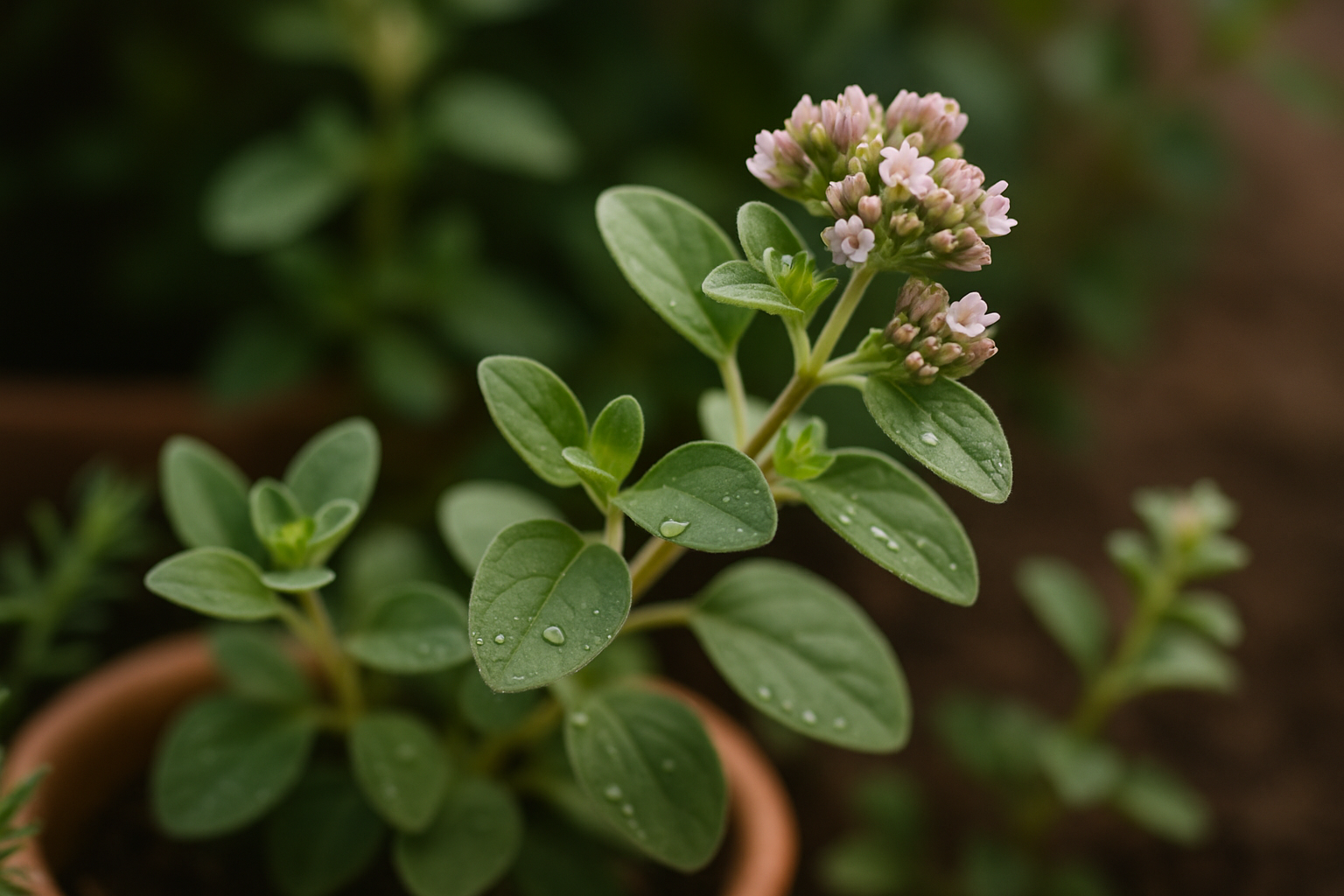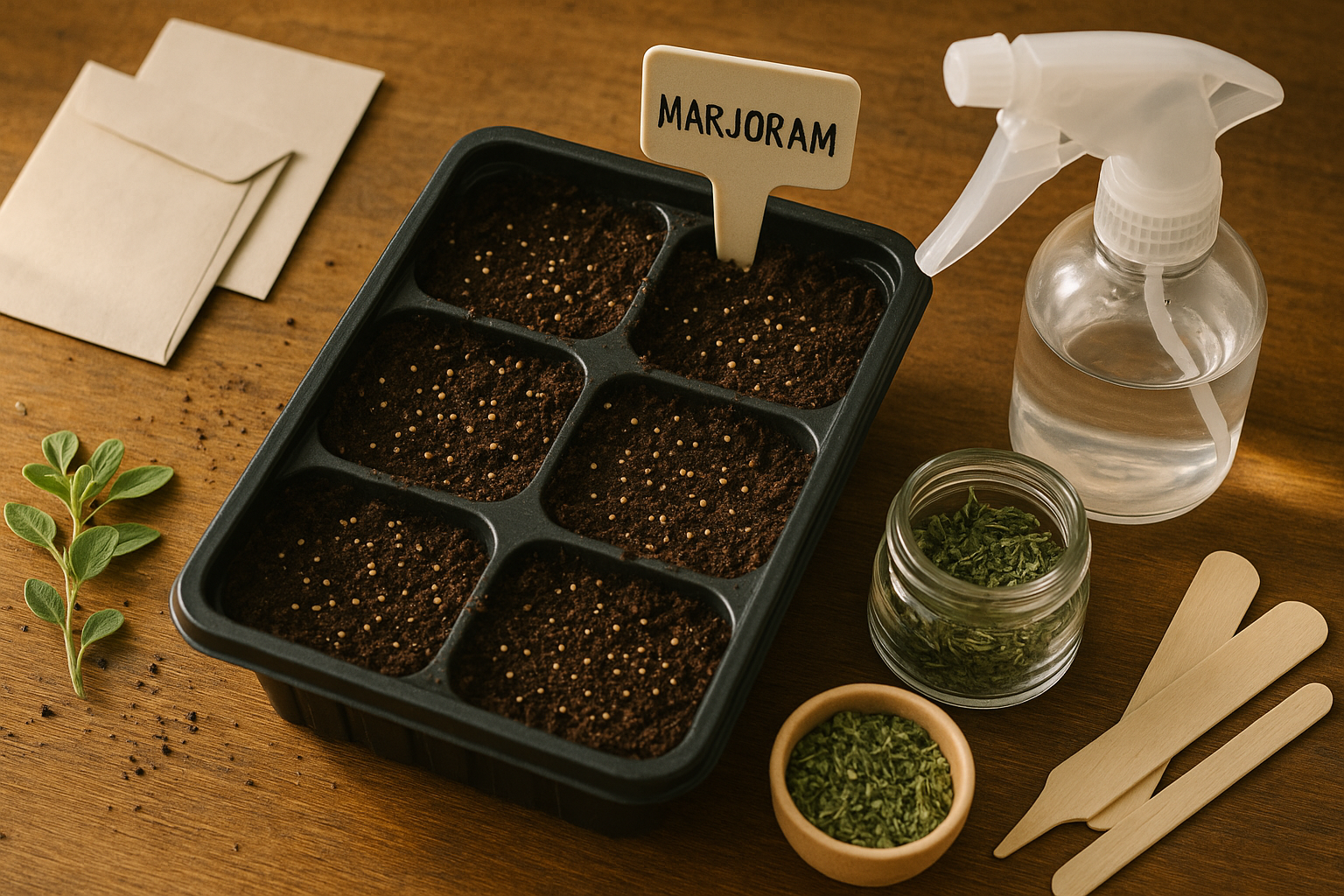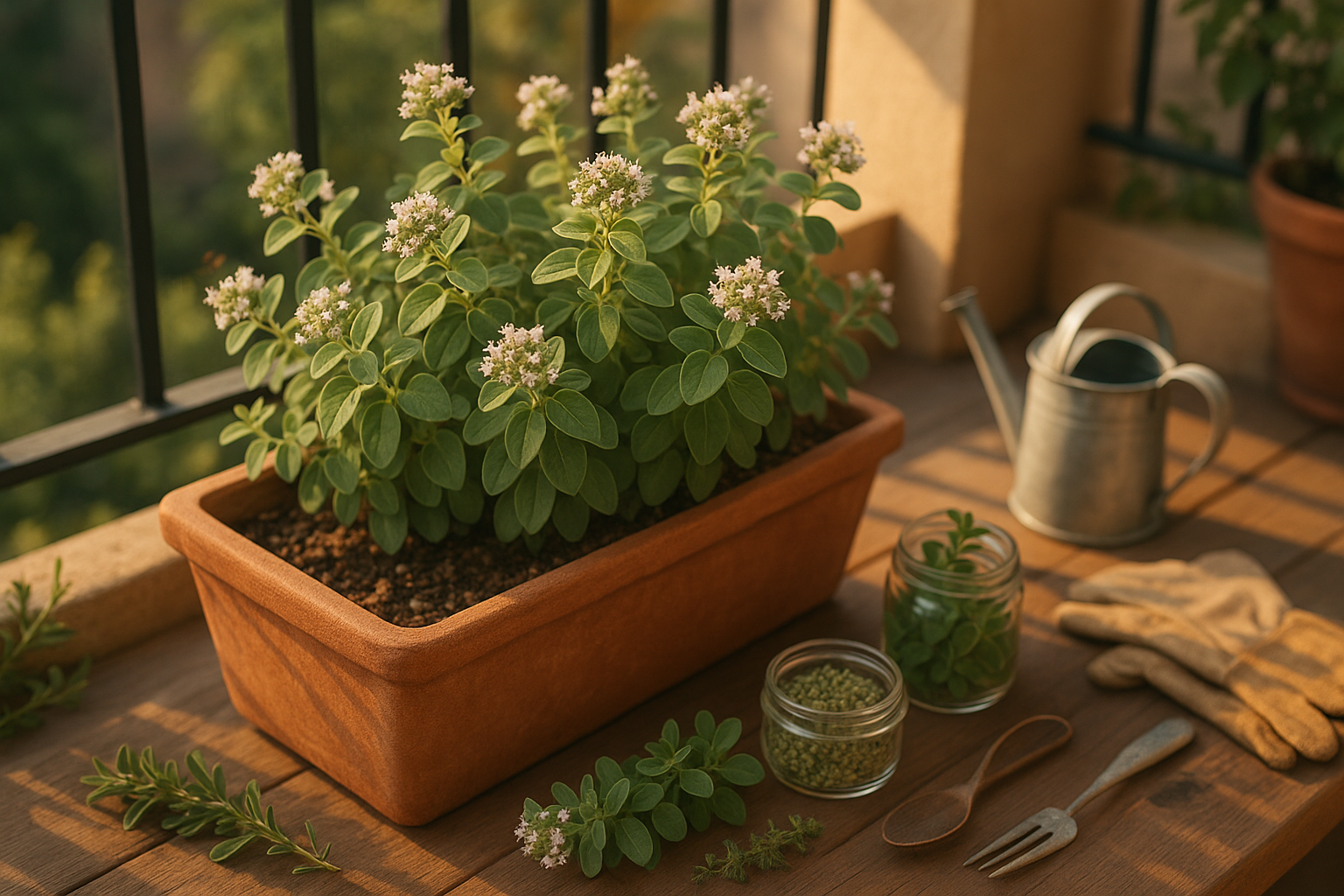What is Marjoram?

If you’re interested in marjoram balcony growing, you’re about to discover why this fragrant herb is so rewarding for small-space gardeners. Marjoram (Origanum majorana) is a tender perennial famed for its sweet, slightly citrusy flavor with a subtle hint of pine, making it a favorite in Mediterranean cuisines. Its small, oval leaves release an inviting aroma when touched, adding a sensory delight right outside your window.
Marjoram’s flavor is gentler and sweeter than its close cousin oregano, which tends to have a more pungent and robust profile. This distinction makes marjoram perfect for finishing soups, salads, poultry, or vegetable dishes that benefit from a delicate herbal note.
Ornamental and Culinary Appeal
Beyond the kitchen, marjoram’s soft green foliage and clusters of tiny white or mauve flowers bring ornamental charm to balcony planters, window boxes, or mixed herb gardens. Popular varieties include sweet marjoram, the most common for culinary use, and pot marjoram, valued both for flavor and visual appeal.
Because marjoram can be easily grown in pots and thrives with limited space and sunlight, it’s a frequent pick for home cooks and plant lovers who want fresh herbs within arm’s reach.
Marjoram vs. Oregano
What sets marjoram apart from oregano is not just the taste—while both belong to the mint family, marjoram’s leaves are smaller, softer, and carry a sweeter fragrance. Gardeners often plant them side by side to distinguish their unique characteristics.
Whether used as a gentle seasoning or as an attractive foliage plant, marjoram’s adaptability and charm make it a top choice for balcony gardens and ornamental containers alike.
Choosing the Right Marjoram Variety
When it comes to choosing the right marjoram for your garden, understanding the differences between sweet, wild, and pot marjoram can help you get the best results.
Sweet marjoram (Origanum majorana) is the most popular in kitchens, prized for its mild, slightly sweet flavor that enhances soups, salads, and poultry dishes. This variety thrives in warm climates and grows well in containers, making it a beginner-friendly choice for home cooks and gardeners.
Wild marjoram, also known as oregano (Origanum vulgare), is hardier and more pungent—perfect for those who enjoy robust flavors and plan to use it in Mediterranean or Italian recipes. It tolerates cooler temperatures and can spread quickly, making it great for outdoor herb beds.
Pot marjoram (Origanum onites) falls between the two, offering a strong aroma and attractive appearance. This makes it a favorite for ornamental borders as well as flavoring food.
If you’re new to growing herbs, stick with sweet marjoram for its adaptability and forgiving nature. For colder regions, wild marjoram’s resilience might suit you better. Consider your cooking habits, local climate, and desire for decorative foliage before picking a variety.
Don’t be afraid to try more than one type; marjoram is easy to start from seed, and planting a few allows you to discover which works best in your garden and kitchen.
Sowing and Planting Marjoram

To start marjoram from seeds, sow them indoors about 6 to 8 weeks before the last expected frost. Simply sprinkle the tiny seeds on the surface of moist seed-starting mix and press them down lightly without covering, as marjoram needs light to germinate. Keep the trays in a warm spot—ideally 65-70°F—and mist occasionally to keep the soil damp, not soggy. You should see sprouts in 14-21 days.
For cuttings, snip healthy, non-flowering stems about 4 inches long from a mature marjoram plant. Strip the lower leaves and place the cuttings in water or moist potting mix until roots develop, usually within two weeks.
Marjoram thrives in well-drained, sandy or loamy soil with a pH of 6.5 to 7.0, and loves full sun—so pick the brightest spot possible. Once your seedlings have grown at least two sets of true leaves and nighttime temperatures stay above 50°F, gradually acclimate them to outdoor conditions by setting them outside for a few hours each day over a week.
To transplant, space marjoram plants about 8-12 inches apart in your garden or containers. Be gentle with their delicate roots and water them in well. If you purchase nursery plants instead, check that they look healthy and pest-free, then follow the same transplanting steps.
Wherever you plant, avoid heavy clay soils and overwatering, as marjoram is prone to root rot when too wet. Light mulching can help keep weeds at bay, while regular pinching encourages bushier growth. With these simple steps, you’ll have fragrant marjoram ready for harvest all season long.
Everyday Marjoram Care
Caring for marjoram day-to-day is fairly simple, but a few key routines can make all the difference in keeping your plant healthy and aromatic. Water marjoram deeply when the top inch of soil feels dry, but be careful not to overdo it—marjoram hates soggy roots and is prone to rot if left in standing water. Consider using a moisture meter if you’re unsure, and always let container pots drain fully. On hot or windy days, check soil moisture more often, as marjoram in pots dries out faster than garden beds.
When it comes to feeding, marjoram doesn’t demand much, but a light application of balanced, slow-release fertilizer at planting time and a diluted liquid feed every 4–6 weeks during peak growing season will keep its foliage lush. Don’t over-fertilize, as this can reduce essential oil content and flavor.
Maintain marjoram plants by gently mulching with straw, shredded bark, or leaf mold to retain moisture and smother weeds, but keep mulch a couple of inches away from the stems to prevent mold. Regular weeding is also important, as marjoram struggles against aggressive weed competition.
To encourage bushy growth, pinch back stems frequently and trim flower buds unless you want the plant to self-seed. For gardeners with little space, marjoram thrives in containers—just choose a pot at least 6–8 inches wide with good drainage, use quality potting mix, and position it in a sunny spot. Even a small windowsill can yield a cheerful supply for your kitchen, as long as the basics of watering, feeding, and airflow are met.
With these straightforward steps, marjoram will reward you with years of flavorful harvests and easy maintenance.
Pruning, Training, and Problem-Solving
Pruning marjoram is best done in early spring or after flowering. Use clean, sharp scissors or garden shears to trim back about one-third of the plant, snipping just above a pair of healthy leaves. This encourages bushier new growth and prevents your marjoram from becoming leggy or woody.
Regularly pinching off the top few inches, especially before the plant flowers, not only keeps it compact but also boosts the essential oils, enhancing its flavor for culinary use.
If you want to shape your marjoram or encourage even more branching, try a simple training technique: gently bend young stems outward and secure them loosely with twine or small stakes, spacing them apart to let in sunlight. Consistent pinching and shaping help create a lush, rounded plant that looks attractive in pots or garden beds.
Watch for common pests like aphids and spider mites; blast them off with a strong stream of water or introduce natural predators like ladybugs.
Powdery mildew and root rot can be an issue if marjoram is in humid conditions or soggy soil, so always ensure good airflow and allow the soil to dry between waterings. For disease prevention, water at the base of the plant and remove any infected foliage promptly.
By staying attentive and using these easy organic methods, you’ll enjoy healthier, more productive marjoram all season long.
Harvesting and Preserving Marjoram
Marjoram is ready to harvest just as the plant begins to flower, when the leaves are most aromatic and flavorful. Look for clusters of small buds and a strong, pleasant scent. For the best results, snip stems in the mid-morning after the dew has dried but before the sun gets too hot—this helps preserve essential oils.
Use clean, sharp scissors and cut above a set of healthy leaves to encourage regrowth.
Drying Marjoram
To dry marjoram, tie small bundles of stems and hang them upside down in a well-ventilated, dark place. Keep them out of direct sunlight, as it can cause the leaves to lose their color and flavor quickly. If space is tight, spread the leaves on a baking sheet and dry them in the oven on the lowest setting with the door slightly open.
Freezing Marjoram
For freezing, strip the leaves from the stems, spread them on a baking tray to freeze individually, then transfer to airtight bags or containers. This prevents clumping and helps retain fresher flavor compared to drying.
Storage Tips
- Store dried leaves in airtight containers away from light and heat sources.
- Label containers with the harvest date and use within a year for the best taste.
- For intense flavor, store dried marjoram whole and crumble only when needed.
Pro Tips
- Add dried or frozen marjoram leaves near the end of cooking to revive their fragrance and flavor.
- Avoid crushing leaves until just before use to maximize essential oil retention.
With these simple steps, you can enjoy garden-fresh marjoram in your kitchen all year round.
Easy Ways to Use Marjoram in the Kitchen
Marjoram brings a gentle, slightly sweet flavor with hints of citrus and pine, making it a versatile herb for any kitchen. It shines in classic Mediterranean dishes like roasted chicken, grilled vegetables, and tomato-based sauces, where its delicate notes enhance without overpowering.
Sprinkle chopped fresh marjoram over baked fish or incorporate it into homemade salad dressings for a fragrant twist. Marjoram is a key player in herb blends like herbes de Provence and Italian seasoning, mingling well with thyme, oregano, basil, and parsley—try substituting marjoram for oregano when you want a subtler touch.
It complements dairy, working beautifully in compound butters or ricotta cheese spreads, and it’s fantastic with eggs—add a pinch to omelets or quiches. You can infuse marjoram into olive oil for dipping bread, or steep the leaves in hot water along with mint or lemon balm for a soothing herbal tea that supports digestion.
Adding fresh marjoram late in the cooking process preserves its delicate aroma; for dried marjoram, incorporate it earlier so the flavors have time to meld.
Beyond flavor, marjoram offers wellness perks: it’s traditionally valued for its anti-inflammatory and digestive properties, and it’s naturally rich in antioxidants that help combat free radical damage.
Whether you’re stirring it into soups, sprinkling it over roasted meats, or blending it into marinades, marjoram not only boosts the taste but also adds a subtle layer of health benefits to everyday meals.
Experiment to find your favorite pairings—try marjoram with lemon zest for a bright finish, or with garlic and onions for a comforting base in stews and casseroles.
